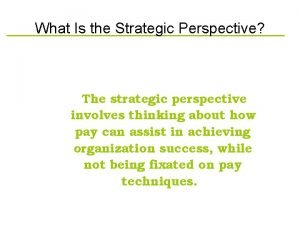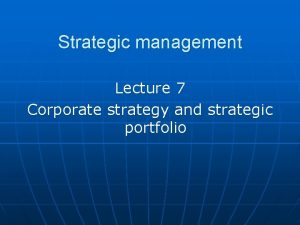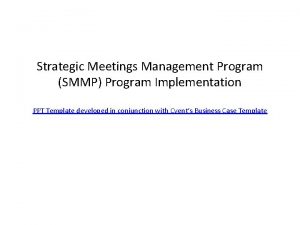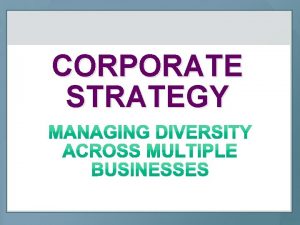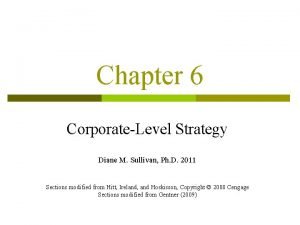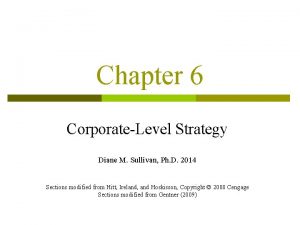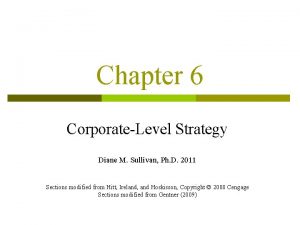PART 2 STRATEGIC PERSPECTIVE Chapter 6 CORPORATELEVEL STRATEGY
























- Slides: 24

PART 2 STRATEGIC PERSPECTIVE Chapter 6 CORPORATELEVEL STRATEGY © 2017 Cengage Learning®. May not be scanned, copied or duplicated, or posted to a publicly accessible website, in whole or in part.

Learning Objectives • Understand that corporate-level strategies include decisions regarding diversification and vertical integration. • Describe the difference between related and unrelated diversification and outline the advantages and disadvantages of each approach. • Explain the reasons why firms decide to pursue diversification. • Describe the process of vertical integration and explain the reasons why a firm would choose to pursue this path. © 2017 Cengage Learning®. May not be scanned, copied or duplicated, or posted to a publicly accessible website, in whole or in part.

Developing a Corporate-Level Strategy • Corporate-level strategy – The way a company seeks to create value through the configuration and coordination of multimarket activities • Corporate advantage – Occurs when a firm maximizes its resources to build a competitive advantage across its business units © 2017 Cengage Learning®. May not be scanned, copied or duplicated, or posted to a publicly accessible website, in whole or in part.

Corporate-Level Strategy Choices Scope The markets and businesses the firm will compete in Organizational design The manner in which activities of the firm will be coordinated Ownership The relationship between business units © 2017 Cengage Learning®. May not be scanned, copied or duplicated, or posted to a publicly accessible website, in whole or in part.

Corporate-Level Strategy Decisions • “Big Bets” – Motivation to pursue diversification strategies – Diversification into international markets – Whether the firm should vertically integrate © 2017 Cengage Learning®. May not be scanned, copied or duplicated, or posted to a publicly accessible website, in whole or in part.

History of Diversification Single-Core Business Focus Related (Horizontal) Diversification Acquisition of competitors Reversal of Diversification Corporate raiders Institutional investor activism Vertical Diversification Acquisition of suppliers 1900 s Unrelated Diversification Opportunistic expansion 1950 Celler. Kefauver Act of 1950 1960 -1970 1980 s Reagan Era Deregulation © 2017 Cengage Learning®. May not be scanned, copied or duplicated, or posted to a publicly accessible website, in whole or in part. 2000 s

Approaches to Diversification A firm may engage in several different businesses that may or may not be related in an attempt to create more value than if the businesses existed as stand-alone entities • Single-product strategy – A firm focuses on one specific product, typically in one market • Horizontal (related) diversification – A firm pursues businesses that share a similar set of tangible and intangible resources © 2017 Cengage Learning®. May not be scanned, copied or duplicated, or posted to a publicly accessible website, in whole or in part.

Approaches to Diversification • Unrelated diversification – A firm that manages several businesses with no connection • Economies of scope – Exists when the costs of operating two or more businesses or producing two or more products with the same corporate structure is less than the costs of operating the businesses independently or producing each product separately © 2017 Cengage Learning®. May not be scanned, copied or duplicated, or posted to a publicly accessible website, in whole or in part.

General Reasons for Diversification • Why diversify? – The opportunity for growth – The opportunity to leverage core assets or skills between different businesses – The potential for personal gain – The potential to manage or minimize risk © 2017 Cengage Learning®. May not be scanned, copied or duplicated, or posted to a publicly accessible website, in whole or in part.

General Reasons for Diversification Synergy: Created when a firm generates sustainable cost savings by combining duplicate activities or deploying underutilized assets across multiple businesses © 2017 Cengage Learning®. May not be scanned, copied or duplicated, or posted to a publicly accessible website, in whole or in part.

Related Diversification • Creating value through sharing and transferring of resources and skills – Sharing sales forces, advertising expenses, distribution channels for similar products – Exploiting closely related technologies or research and development activities – Transferring operational knowledge or processes – Leveraging a firm’s strong brand name and reputation across multiple product lines © 2017 Cengage Learning®. May not be scanned, copied or duplicated, or posted to a publicly accessible website, in whole or in part.

Reasons for Pursuing Related Diversification • Transferring skills leads to competitive advantage when: – The activities involved in the business are similar enough that sharing expertise is meaningful – The transfer of skills involves activities important to competitive advantage – The skills transferred represent a significant source of competitive advantage for the receiving unit © 2017 Cengage Learning®. May not be scanned, copied or duplicated, or posted to a publicly accessible website, in whole or in part.

Reasons for Pursuing Related Diversification • Sharing of resources leads to competitive advantage when: – Sharing of resources allows the firm to spread fixed costs across its business units – Sharing of internal functions among units creates economies of scope – Sharing of intangible resources results in the transfer of internal value for business units © 2017 Cengage Learning®. May not be scanned, copied or duplicated, or posted to a publicly accessible website, in whole or in part.

Unrelated Diversification A firm that manages several businesses with no reasonable connection • Financial economies – Cost savings that a firm achieves through the distribution of capital among business units • By efficiently allocating capital among units • By purchasing a business and restructuring its assets with the goal of selling it back into the marketplace at a higher price © 2017 Cengage Learning®. May not be scanned, copied or duplicated, or posted to a publicly accessible website, in whole or in part.

Reasons for Pursuing Unrelated Diversification • To reduce the overall risk of the business through the efficient distribution of capital between business units • To allow for the use of capital from a profitable division to sustain a failing firm for a period of time • To acquire undervalued assets and attempt to raise their value through specific restructuring activities © 2017 Cengage Learning®. May not be scanned, copied or duplicated, or posted to a publicly accessible website, in whole or in part.

Figure 6. 5 > The Diversification Test Source: Adapted from Michael E. Porter, “From Competitive Advantage to Corporate Strategy, ” Harvard Business Review, May–June 1987. © 2017 Cengage Learning®. May not be scanned, copied or duplicated, or posted to a publicly accessible website, in whole or in part.

Figure 6. 6 > Impact of Diversification on Firms’ Performance © 2017 Cengage Learning®. May not be scanned, copied or duplicated, or posted to a publicly accessible website, in whole or in part.

Vertical Integration Occurs when one corporation owns business units that make inputs for other business units in the same corporation • Forward integration – Occurs when a firm owns or controls the customers or distribution channels for its main products • Backward integration – Occurs when a firm owns or controls the inputs it uses © 2017 Cengage Learning®. May not be scanned, copied or duplicated, or posted to a publicly accessible website, in whole or in part.

Costs Associated with Vertical Integration • Administrative costs – The costs of coordinating activities between business units • Transaction costs – Costs to obtain products or services from a contractor or supplier as well as the costs associated with writing and administering the contracts for these products and services © 2017 Cengage Learning®. May not be scanned, copied or duplicated, or posted to a publicly accessible website, in whole or in part.

Figure 6. 7 > Backward and Forward Integration © 2017 Cengage Learning®. May not be scanned, copied or duplicated, or posted to a publicly accessible website, in whole or in part.

Figure 6. 8 > Advantages and Disadvantages of Vertical Integration Source: Charles W. L. Hill and Gareth R. Jones, Strategic Management: An Integrated Approach, 2 nd edition (Boston, MA: Houghton Mifflin Company, 1992), pp. 208– 212; and Kathryn Rudie Harrigan, “Formulating Vertical Integration Strategies, ” Academy of Management Review, Vol. 9, No. 4, 1984, pp. 638– 652. © 2017 Cengage Learning®. May not be scanned, copied or duplicated, or posted to a publicly accessible website, in whole or in part.

Alternatives to Vertical Integration • Spot contracts – Allow a buyer to purchase a commodity at a specific price • Outsourcing – Contracting with a firm outside the corporation to perform certain tasks or functions that the corporation used to do on its own © 2017 Cengage Learning®. May not be scanned, copied or duplicated, or posted to a publicly accessible website, in whole or in part.

Outsourcing • Advantages – Reduces the costs of the firm’s noncore value chain activities – Allows a firm to focus more on core functions in its value chain • Disadvantages – Outsourcing of too many activities may damage the firm’s internal core competencies and capabilities – Outsourcing may isolate a firm from its external market © 2017 Cengage Learning®. May not be scanned, copied or duplicated, or posted to a publicly accessible website, in whole or in part.

KEY TERMS Administrative costs Backward integration Corporate advantage Diversification Economies of scope Financial economies Forward integration Market power Outsourcing Related diversification Single-product strategy Spot contracts Synergy Transaction costs Unrelated diversification Vertical integration © 2017 Cengage Learning®. May not be scanned, copied or duplicated, or posted to a publicly accessible website, in whole or in part.
 One point perspective boxes
One point perspective boxes Silo perspective vs business process perspective
Silo perspective vs business process perspective Perspective strategy example
Perspective strategy example Fighting means corporations
Fighting means corporations Strategic fit vs strategic intent
Strategic fit vs strategic intent Puppy dog ploy strategy
Puppy dog ploy strategy Strategic management and strategic competitiveness
Strategic management and strategic competitiveness Cultural aspects of strategy choice
Cultural aspects of strategy choice Crafting and executing strategy in strategic management
Crafting and executing strategy in strategic management What is functional strategy
What is functional strategy What is corporate strategy in strategic management
What is corporate strategy in strategic management Directional strategy in strategic management
Directional strategy in strategic management Entry strategy and strategic alliances
Entry strategy and strategic alliances Cooperative strategy in strategic management
Cooperative strategy in strategic management Strategic meetings management program
Strategic meetings management program Factors affecting strategic choice
Factors affecting strategic choice Factors affecting strategic choice
Factors affecting strategic choice Market entry modes for international businesses chapter 7
Market entry modes for international businesses chapter 7 Making strategy: mapping out strategic success
Making strategy: mapping out strategic success Strategy
Strategy Functional strategies in strategic management
Functional strategies in strategic management Hypercompetition
Hypercompetition Types of functional level strategy
Types of functional level strategy Addition symbol
Addition symbol Part to part ratio definition
Part to part ratio definition


